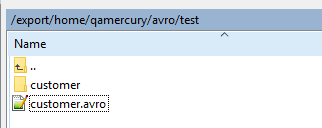PowerExchange Adapters for Informatica
- PowerExchange Adapters for Informatica 10.5
- All Products

java.lang.AssertionError: assertion failed: Empty partition column value in '< >' at scala.Predef$.assert(Predef.scala:170)

Name
| ID
| SSN
|
|---|---|---|
Anna
| 1
| 1
|
John
| 4
| 4
|
Smith
| 4
| 4
|
John
| 5
| 5
|
Anna
| 2
| 2
|
Directory
| Description
|
|---|---|
target1.avro=Anna
| In
target1.avro=Anna directory, the Data Integration Service creates one file with the following value:
1,1,1,2,2,2 .
|
target1.avro=John
| In
target1.avro=John directory, the Data Integration Service creates one file with the following values:
4,4,4,5,5,5 .
|
target1.avro=Smith
| In
target1.avro=Smith directory, the Data Integration Service creates one file with the following values:
4,4,4 .
|
Directory
| Description
|
|---|---|
target1.avro=Anna
| In
target1.avro=Anna directory, the Data Integration Service creates two files with the following value:
1,1,1 and
2,2,2
|
target1.avro=John
| In
target1.avro=John directory, the Data Integration Service creates two files with the following value:
4,4,4 and
5,5,5 .
|
target1.avro=Smith
| In
target1.avro=Smith directory, the Data Integration Service creates one file with the following value:
4,4,4 .
|